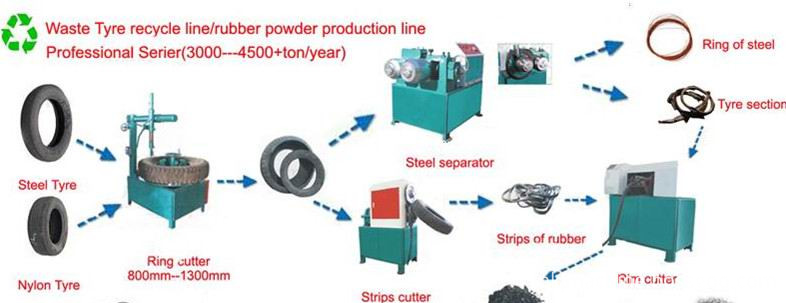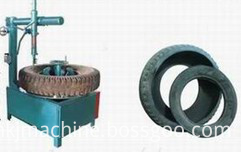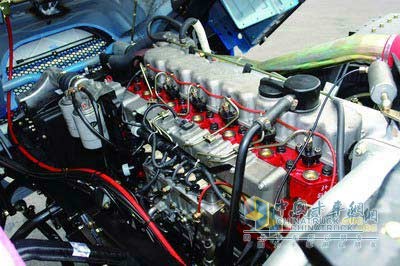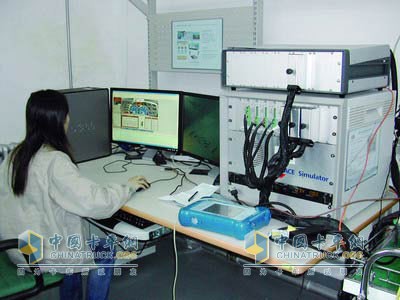Editor's note: In July 2008, China fully implemented the National III emission standards. “One stone provokes thousands of layers of wavesâ€, and China’s commercial vehicle market in the “III†era is very lively. For a time, the product technology line struggles and market competition has become hot. "High-pressure common rail" and "EGR" (exhaust gas recirculation), these words frequently enter people's attention and attract the attention of the public. At the same time, FAW, as an important commercial vehicle production base in China, is particularly low-key. Facing the country III standard, what kind of thinking does FAW have? What is the specific situation of its independent development of the electronic control unit pump system? With these questions, the reporter came to Changchun and entered the FAW Technology Center.
The picture shows the FAB production EUPI production line In November, Changchun entered the winter and was cold. When reporters walked into the FAW Technology Center (hereinafter referred to as “the centerâ€), they immediately felt a warm and harmonious working atmosphere. Every employee was busy in an orderly manner. Leaders and employees interviewed talked about self-developed FEUPI (FAW). Electronic Unit Pump Integration, FAW integrated electronic control unit pump system, is full of emotions. "Independent innovation can not be empty talk, there must be real products." Speaking of self-developed FEUPI, the center director Li Jun is full of confidence. “From the first batch of applications of the Beijing sanitation trucks in 2006 to the mass market this year, more than 6,000 units of the State III engine that matches FEUPI have been sold, and the market has responded well.†Chief of the central engine attachment department Ge Fei added with specific figures.
Assembled with FEUPI's CA6DE3 engine â– Decisive decision-making independent development of electronic monomer pump system Implementing State III emission standards has enabled China's diesel engines to enter a new stage of technological upgrading, and at the same time, it has also caused domestic related companies to encounter unprecedented challenges. In the face of hand-held core technology, the powerful international monopoly companies and what measures are taken to deal with it are issues that every diesel engine manufacturer has to ponder. "Control of core technologies is a strategic issue for companies." Li Jun's words indicate FAW's attitude and determination, that is, independent research and development, mastering core technologies. Entering the new century, FAW is keenly aware that with the increasingly prominent environmental issues and the upgrading of diesel technology, if China does not develop its own electronically controlled fuel injection system, the Chinese diesel engine industry will face the dilemma of being controlled by people. In light of this, FAW borrowed advanced international technical experience and embarked on an independent R&D road for diesel engine EFI systems. From a technical point of view, for a direct injection diesel engine, to achieve State III emission, the fuel injection system must have two technical characteristics: First, there must be more than 1200 Pa of injection pressure to reduce particulate emissions; secondly, to achieve The flexible control of injection timing is used to solve the conflict between nitrogen oxide emissions and fuel consumption. At present, mature technologies commonly used in the world mainly include high pressure common rail systems, electronically controlled pump nozzle systems, and electronically controlled monomer pump systems. Although the high-pressure common rail technology is the most advanced, it has a high cost, high quality requirements for oil products, and it is very difficult to achieve localization in a short time. "To do a localized product." Ge Fei's words left a deep impression on reporters. Because the electronically controlled monomer pump system not only has the technical characteristics of achieving State III emission, but also has a relatively low degree of localization. Therefore, while studying the common rail system, in 2002, FAW decided decisively to start the electronically controlled monomer pump system. The development to master the core technology of the National III diesel engine as soon as possible.
Staff introduced the simulation test situation of FEUPI control system â– "I Strategy" and "Dagger Action" During the interview, the "I Strategy" and the "Dagger Operation", two special and loud terms, caught the attention of reporters. "The 'I' in FEUPI is an abbreviation of the English word "integration". We recognize that the most convenient way to break the monopoly pattern of foreign EFI suppliers is to use global resources and take the integrated innovation route. There was a proposal for 'I Strategy'.†For example, Ge Fei told reporters, “For example, in the development of FEUPI, we used Delphi's single pump, Motorola’s ECU, and Siemens’ sensors. FAW completed the system definition and proposed solutions and requirements. The supplier is only responsible for product design and production." No doubt, such as Bosch, Denso and other international system suppliers, they only provide customers with the entire EFI system, including hardware and software, in order to retain the right to speak on the price of the product, while firmly controlling the core technology. The implementation of "I Strategy" has successfully broken the way that foreign suppliers only provide a complete system of supply, and is a major step on the road to independent research and development. Some people may think that the components used in such an integrated development system are still provided by international suppliers and no substantial breakthrough has been made. However, in fact, there is a qualitative difference between integrated innovation and overall system procurement, which involves another important strategy of FAW--“Operation Decapitationâ€. What is the "first" and how to "go"? As a member of the "beheading" team, Li Suwen, a software engineer at the development center of the electronic control unit, unravels the doubts in the reporter's mind. “If we compare FEUPI to the human body, then the control system is equivalent to its 'brain'. To implement the FEUPI integration strategy, the development of the control system is a prerequisite. Only by mastering the control software and having the 'brain', can we have each Controlled objects integrate the capital and form a truly autonomous EFI system," said Li Suwen. To carry out integrated innovation requires not only innovative strategies but also integrated capabilities. At the beginning of the development of FEUPI, FAW was committed to the autonomous development of the electronic control system and drastically “started†the “firstâ€. According to reports, the development of the FEUPI control system can be divided into two phases. "From 2002 to 2005, it was a stage of technological development. During this period, we learned from the experience accumulated in the development of electronic governors before, combined with the national 863 project 'Embedded software platform for automotive electronics', together with Jilin University and Zhejiang University. The design of the control system was completed.†Li Suwen said, “From 2006 to 2008, we entered the product development stage. The control system must be put into mass production, and we must solve the problems faced in production and after-sales service. At present, production Downline adjustment tools and fault diagnostic tools have all been developed and the system already has mass production capabilities and after-sales maintenance measures, enabling the transformation from technology development to product development." The road to independent research and development is undoubtedly an arduous task. It is even more difficult to develop products that can compete with international mature systems. "A series of problems including the coordination of the speed sensor and the phase sensor, and the idle speed control of the engine can only be solved one by one through a long period of exploration and practice." Li Suwen said, "Especially, the overall structure of the control system is built. Because of the engine work The situation is complex. At the beginning of the project, the overall concept of the overall system structure is very difficult. It can only be gradually improved as the development progresses. Now, the “behavior of the dagger†has been completed. The bittersweet and hottest among them, only Li Suwen is in this category. People can have a deep understanding. â– Take the opportunity to fully enhance the electronic control research and development capabilities “Technical innovation should be considered in the long term. Having an autonomous National III engine is only an immediate result.†Li Kang, senior engineer at the central engine division, reflects the R&D mentality of FAW people facing the future. With the full implementation of the National III emission regulations, China's trucks have entered the electronic age. In the future technology upgrade of diesel engines, EGR systems, variable superchargers, and cooling systems must all be electronically controlled. Obviously, who owns the electronic control technology, whoever has mastered the dominance of the future diesel engine market. “It is precisely due to the development of FEUPI that our electronic control R&D capability has been fully enhanced.†Li Jun said in a word that FAW had made the biggest gain in the FEUPI development process. "The process system and management experience learned during FEUPI development have been fully applied in later projects." Li Suwen told reporters. In order to guarantee the quality of the FEUPI control system, FAW decided to adopt a V-type development process that was not familiar with the country at the time by studying the internal personnel structure. “In 2005, 70% of the employees in the department took a 3-month training at Motorola headquarters to learn the development process and management knowledge. Through learning and communication, everyone accepted new development ideas and processes from an ideological point of view. Obviously, the discussions with the trainers were very enthusiastic. Sometimes due to disagreements, the two parties would even have fierce debates. Therefore, everyone has a deep understanding of the new process.†Li Suwen said, “Now, all projects in the department are in accordance with V-type development process to operate. Document management, process control is very complex, but the product quality has been a strong guarantee." With the development experience of FEUPI, at present, the road for R&D of FAW electronic control system has been getting wider and wider, and the road has gone further. “We have developed a high-pressure common rail control system in just over two years and have now entered the road test stage.†Li Suwen said with pride. â– FEUP realizes higher pursuit of FAW's independent R&D Innovation is not a momentary move. The driving force behind corporate development is continuous innovation. With the development of FEUPI, FAW people realized that due to the lack of master key technology such as single pump, the cost advantage of the system was not obvious. Therefore, in 2004, FAW started to implement FEUP (FAW's autonomous electronically controlled monomer pump system. ) The development of integrated innovation and original innovation is a two-pronged approach. "The biggest difference between FEUPI and FEUP is that the former uses the single pump provided by Delphi, while the monomer pump in FE?é„„UP is completely developed and produced by FAW," said Ge Fei. Based on the in-line pump manufacturer, it is possible to use existing facilities to produce monomer pumps without the need for large-scale equipment investment. FAW and Hengyang ASIMCO Nanyue Co., Ltd. (hereinafter referred to as “Nanyueâ€) unite to break through the leakage of the solenoid valve package surface without leakage. The six major technical difficulties, including the high-strength design of the aluminum pump body, were developed by FEUP. It is understood that the system integrates the single-unit pump in a single cam box, allowing the original in-line pump engine to achieve State III emission without major modifications. "After localization, the cost of the single pump is reduced by 50%," said Ge Fei. The development of FEUP not only enabled FAW to solve the problem of inadequate engine parts of the State III engine and reduced product costs, but also marked FAW's control over the core technology of the electronically controlled fuel injection system. At the same time, FEUP produced by Nanyue is not only for FAW, but also for a number of engine companies including Yuchai, Dongfeng 49, Yangdong, and Tianjin Perkins, filling the domestically-developed III electric injection system. Product and industry gaps. This is undoubtedly a blessing to our country's diesel engine industry. FAW to reflect the actual action of the automotive industry, "the Republic of the eldest son" style. “At present, FEUP has completed matching development on FAW's DEUTZ, CA6DF3, and CA4DF3 engines, and it has been launched in small batches this year,†Ge Fei told reporters. |
We supply all kinds of single tyre cutters for waste tyre pyrolysis machines:
waste tyre pyrolysis machines is widely used in waste tyre recycling industry
there are serveral models with capacities from 1ton to 5tons per day
saving much labor.
We are a professional Chinese manufacturer of Waste Rubber Pyrolysis Machine, and look forward to your cooperation!


Single-Side Tyre Cutter,Tyre Cutter,Tire Cutter Machine,Car Tire Cutter
Henan Lanning Technology Co., Ltd , http://www.lanningrecycling.com


